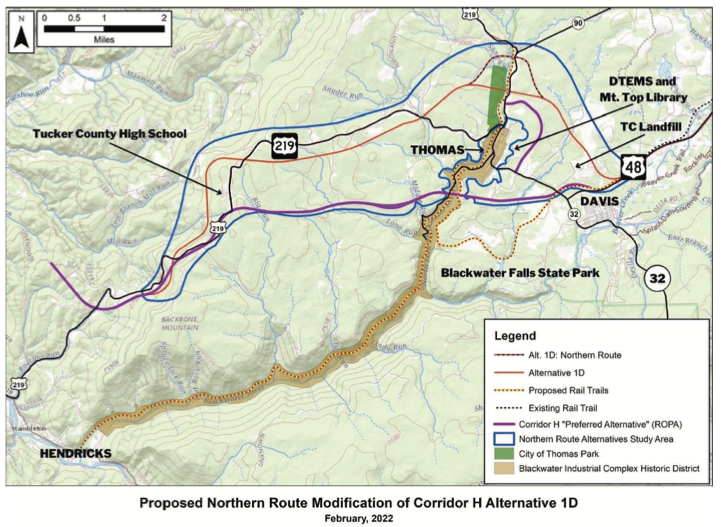By Hugh Rogers
Our story so far, Parsons to Davis chapter: The West Virginia Division of Highways (DOH) has been sued before over its Original Preferred Alignment (OPA). A settlement agreement in 2000 required it to come up with alternatives to spare the Blackwater Area and its historic district. From a tangle of possibilities, DOH found a Northern Route that protects this landscape and skirts the small towns, rather than building a massive interchange between them.
However, when DOH re-started the project in 2019, it showed maps with only the old Original Preferred Alignment, blasting straight across the Blackwater. More than 80% of public comments on this proposalrequested a Northern alternative.
Now, DOH is updating old environmental studies, with a view toward gaining federal approval (and money) next year, and beginning construction in 2024. Besides wildlife and wetlands, geology and vegetation, this review must take into account “changes in the project area”. The vague phrase encompasses social and economic conditions.
Changes there have been, indeed. The number of local businesses more than doubled between 2012 and 2021; as the population grew, home sales set new records. Davis and Thomas are destinations for many more travelers.
Blackwater Falls State Park now attracts more than 1 million visitors annually. The Park is applying for Dark Skies designation—an internationally significant marker, not only for astronomers but for any vacationers seeking relief from urban spaces. The Park, the Monongahela National Forest, the Blackwater Industrial Complex on the rail-trail south of Thomas, all these natural and historic sites would be drastically affected by the sight and noise of an intrusive multilane highway.
Over the past twenty years, local residents and organizations have worked to build hiking and biking trails between the two towns. These cooperative efforts would be jeopardized by a major highway intersection and associated commercial development.
One could say the highway planners have become victims of their own success. The corridor’s completion from the east as far as Davis (except for six miles from the Virginia line to Wardensville) helped to increase economic activity. And it convinced a lot of residents, old and new, about the need to preserve their towns’ charm and protect the Blackwater area.
DOH has hung on to the old alignment primarily because it would be cheaper to build. But what is the cost of not doing it right? Besides the impacts noted above, to the natural landscape, historic sites, and connections between the towns, two more could be mentioned.
Of particular importance to Thomas, truck traffic through town is an increasing annoyance. Going south, it uses the main shopping, eating, live performance and gallery-going street. Northbound traffic is wearing out a retaining wall built by the CCC eighty years ago.
The Original Preferred Alignment would do nothing to solve the problem, so DOH tacked on a steep, two-lane truck route up the hill from Route 32. It is uncertain when or if this separate piece would be built (local officials and DOH employees are doubtful), or if it would be used by reluctant truckers, but clearly it would have negative impacts on the Davis-Thomas elementary/middle school and public library. The Northern Route would make this unnecessary.
The other problem is physical. On the OPA, the bridge that would cross the North Fork of the Blackwater River above the Coketon historic district would rest on an Abandoned Mine Lands reclamation site. The surface consists of old mine spoil; beneath are old mine workings, tunnels filled with acid drainage. This site should not be disturbed.
We’ve been warned about the placement of bridge supports in uncertain terrain. In the section of Corridor H now under construction, triple piers were set on “an old slide.” (The site is shown on the front page of the September Voice.) As a result, the assembly slipped downhill. DOH and Kokosing, the contractor, dispute what the latter was told about the slide.
There’s no secret about the terrain at Coketon, and there’s no need to go that way. With unprecedented funding from the federal infrastructure bill, we can choose the better route.

